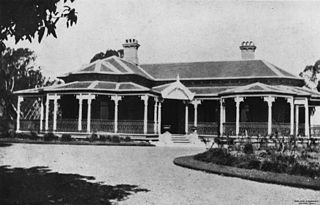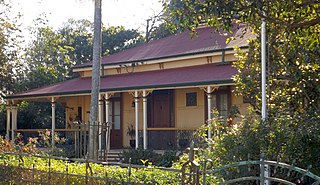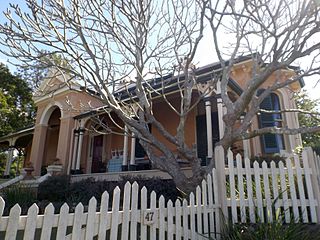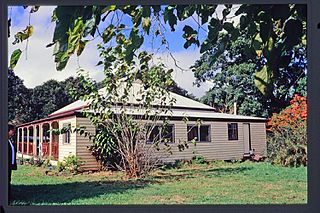
Windermere is a heritage-listed villa at 14 Sutherland Avenue, Ascot, Queensland, Australia. It was built from c. 1886 to 1930s. It was added to the Queensland Heritage Register on 21 October 1992.

Como is a heritage-listed villa at 88 Kadumba Street, Yeronga, City of Brisbane, Queensland, Australia. It was designed by Alexander Brown Wilson and built from 1889 to 1890 by Mr Peterson. It is also known as Barrogill. It was added to the Queensland Heritage Register on 25 August 2000.

Old Bishopsbourne is a heritage-listed house at 233 Milton Road, Milton, City of Brisbane, Queensland, Australia. It was designed by Benjamin Backhouse and built from 1865 to 1959. It is also known as St Francis Theological College and Bishopsbourne. It was added to the Queensland Heritage Register on 21 October 1992.

Chelmer Police College is a heritage-listed former police barracks at 17 Laurel Avenue, Chelmer, City of Brisbane, Queensland, Australia. It was built from 1900 to 1970. It is also known as 10 WRAAC Barracks, The Lady Wilson Red Cross Convalescent Home, and Waterton. It was added to the Queensland Heritage Register on 1 October 2003.

Sherwood Arboretum is a heritage-listed arboretum at 39A Turner Street, Sherwood, Queensland, Australia. A 1946 addition to the site is also known as the John Herbert Memorial Vista. It was added to the Queensland Heritage Register on 3 May 2007.

Eulalia is a heritage-listed villa at 75 McIllwraith Avenue, Norman Park, Queensland, Australia. It was built in 1889. It was added to the Queensland Heritage Register on 21 October 1992.

Shafston House is a heritage-listed villa at 23 Castlebar Street, Kangaroo Point, Queensland, Australia. It was designed by Robin Dods and built from 1851 to 1930s. It is also known as Anzac Hostel, Ravenscott, and Shafston International College. It was added to the Queensland Heritage Register on 7 February 2005.

Hanworth is a heritage-listed villa at 109 Lytton Road, East Brisbane, Queensland, Australia. It was designed by James Cowlishaw built from 1864 to 1930s circa. It is also known as Hanworth Home for the Aged and The Hospice. It was added to the Queensland Heritage Register on 21 December 1997.

Edward Harold Fulcher Swain (1883—1970) was a forester in New South Wales and Queensland, Australia. Swain laid the foundations of modern forestry economics in Queensland.

Woodlands is a heritage-listed detached house at 24 Woodland Street, Ashgrove, City of Brisbane, Queensland, Australia. It was built from 1880s to 1930s. It is also known as Clarke's Farm and Glen Urquhart. It was added to the Queensland Heritage Register on 4 August 1997.

Wilston House is a heritage-listed villa at 47 Watson Street, Newmarket, City of Brisbane, Queensland, Australia. It was designed by architect James Cowlishaw and built from c. 1876 to c. 1880. It was added to the Queensland Heritage Register on 21 October 1992.

Jimna Single Men's Barracks is a heritage-listed workers' housing at 4 Tip Road, Jimna, Somerset Region, Queensland, Australia. It was built in 1930s. It was added to the Queensland Heritage Register on 27 November 2008.

Murrumba Homestead Grounds is a heritage-listed site at 38 Armstrong Street, Petrie, City of Moreton Bay, Queensland, Australia. It was added to the Queensland Heritage Register on 16 February 2009.

Fairview is a heritage-listed house at 15 Porter's Lane, Maleny, Sunshine Coast Region, Queensland, Australia. It was designed and built in 1907 by the Pattemore family. It is also known as Armstrong's House and Pattemore House. It was added to the Queensland Heritage Register on 4 September 2003.

Koongalba is a heritage-listed detached house at 12 Wharf Street, Yandina, Sunshine Coast Region, Queensland, Australia. It was built from 1894 to 1920s. It is also known as John Low's House. It was added to the Queensland Heritage Register on 4 July 1995.

Eskdale is a heritage-listed detached house at 53 Pallas Street, Maryborough, Fraser Coast Region, Queensland, Australia. It was built from c. 1864 to 1920s. It was added to the Queensland Heritage Register on 21 October 1992.

Rockhampton Girls Grammar School is a heritage-listed private school at 155 Agnes Street, The Range, Rockhampton, Rockhampton Region, Queensland, Australia. It was designed by Edwin Morton Hockings and built in 1890 by Moir Cousins and Co. It was added to the Queensland Heritage Register on 20 October 2000.

Branyan Road State School is a heritage-listed state school at Branyan Drive, Branyan, Bundaberg, Bundaberg Region, Queensland, Australia. It was designed by Queensland Department of Public Works and built in 1905. It was added to the Queensland Heritage Register on 1 May 2015.

Marburg State School is a heritage-listed state school at Louisa Street, Marburg, City of Ipswich, Queensland, Australia. It was designed by Queensland Department of Public Works and built in 1922. It is also known as Marburg Rural School. It was added to the Queensland Heritage Register on 9 October 2015.

Virginia State School is a heritage-listed state school at 1690 Sandgate Road, Virginia, City of Brisbane, Queensland, Australia. It was designed by Queensland Department of Public Works and built from 1920 to 1933. It was added to the Queensland Heritage Register on 28 August 2015.
























